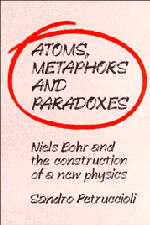Book contents
- Frontmatter
- Contents
- Introduction
- 1 The paradigm of complementarity
- 2 Atomic model and quantum hypotheses
- 3 The principle of correspondence
- 4 The theory of virtual oscillators
- 5 The conceptual foundation of quantum mechanics
- 6 The Bohr—Einstein confrontation: phenomena and physical reality
- General bibliography
- Name index
- General index
3 - The principle of correspondence
Published online by Cambridge University Press: 10 November 2009
- Frontmatter
- Contents
- Introduction
- 1 The paradigm of complementarity
- 2 Atomic model and quantum hypotheses
- 3 The principle of correspondence
- 4 The theory of virtual oscillators
- 5 The conceptual foundation of quantum mechanics
- 6 The Bohr—Einstein confrontation: phenomena and physical reality
- General bibliography
- Name index
- General index
Summary
At the beginning of the paper presented at Como in 1927 Bohr stated: ‘On the one hand, the definition of the state of a physical system, as ordinarily understood, claims the elimination of all external disturbances. But in that case, according to the quantum postulate, any observation will be impossible, and, above all, the concepts of space and time lose their immediate sense. On the other hand, if in order to make observation possible we permit certain interactions with suitable agencies of measurement, not belonging to the system, an unambiguous definition of the state of the system is naturally no longer possible, and there can be no question of causality in the ordinary sense of the word. The very nature of the quantum theory thus forces us to regard the space-time coordination and the classical theories, as complementary but exclusive features of the description, symbolizing the idealization of observation and definition respectively’.
The contrast effectively illustrated between possibilities of definition and conditions of observation thus expresses the cognitive scope of quantum theory and summarizes the complementary and irreducible aspects of the description of objects belonging to the microworld. In Bohr's view, this contrast is the direct consequence of two general assumptions: the postulate regarding the discontinuity or individual nature of atomic processes, symbolically represented by the quantum of action, and an epistemologically binding judgement on the system of concepts whereby such processes may be described.
- Type
- Chapter
- Information
- Atoms, Metaphors and ParadoxesNiels Bohr and the Construction of a New Physics, pp. 78 - 110Publisher: Cambridge University PressPrint publication year: 1993



